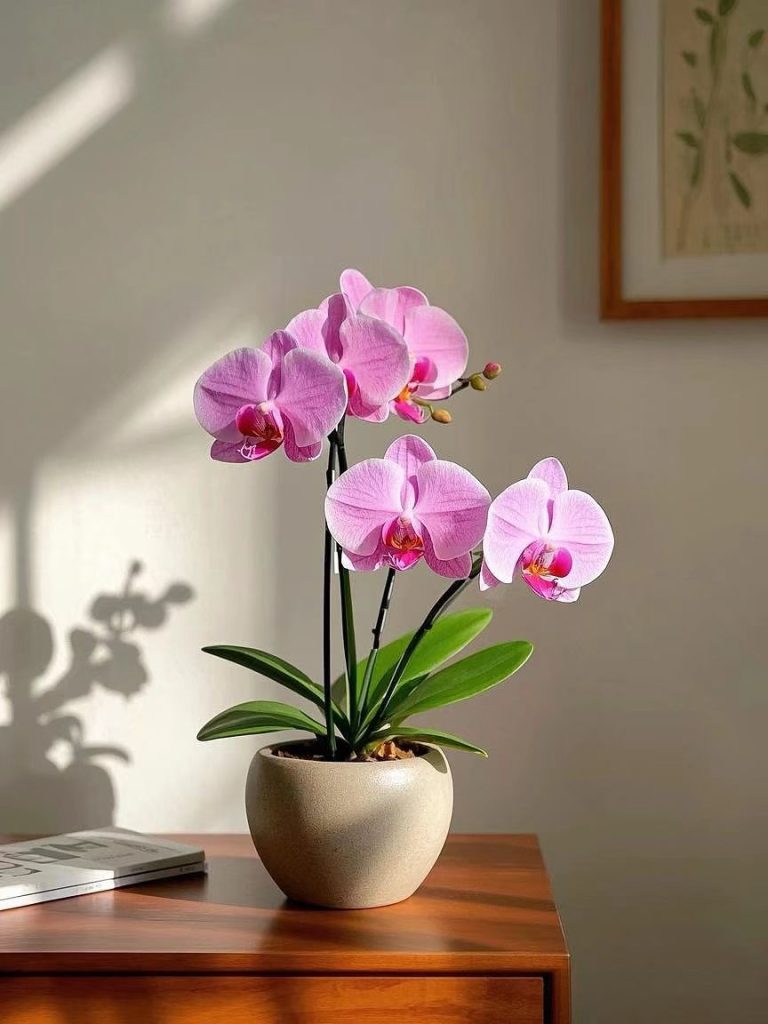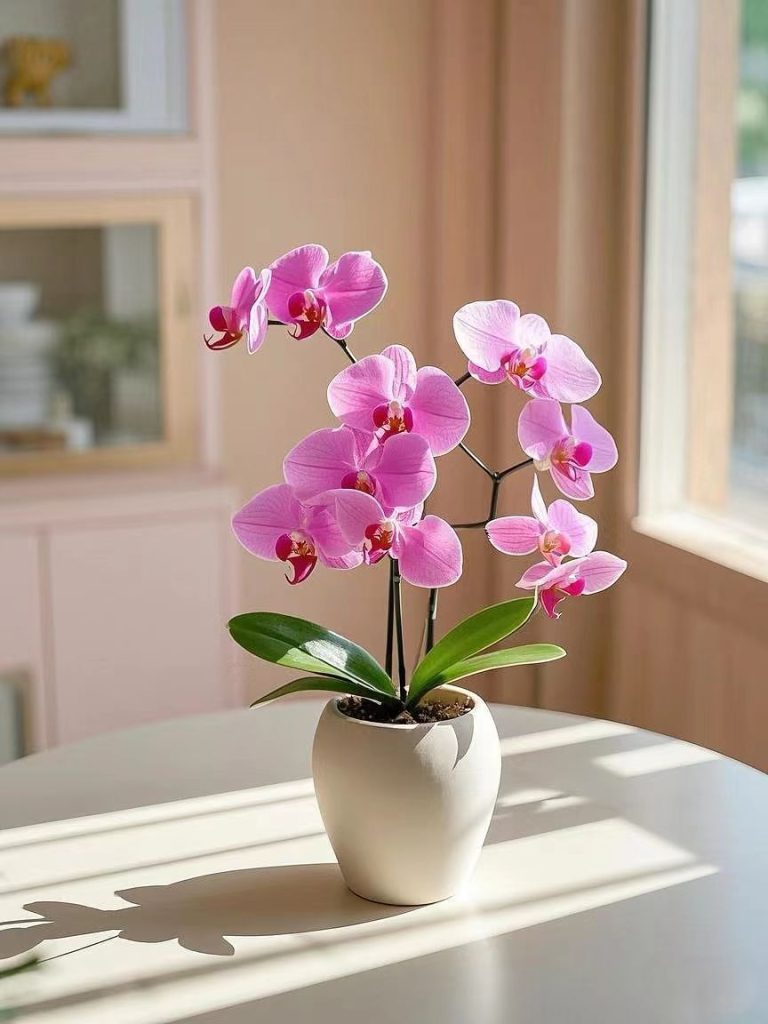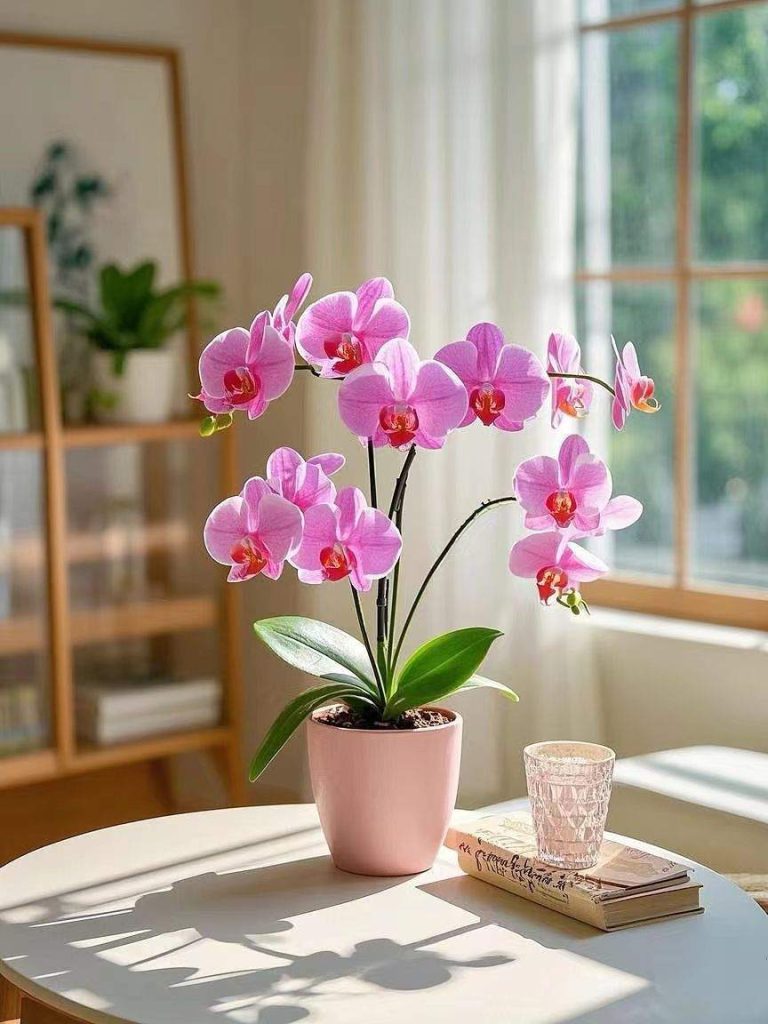Phalaenopsis Care: The Ultimate Guide to a Stunning, Long-Lasting Bloom
H1: Phalaenopsis Care: The Ultimate Guide for a Stunning, Long-Lasting Bloom
Often called the “moth orchid,” Phalaenopsis is the perfect houseplant, capable of blooming for months with elegant, butterfly-like flowers. This complete guide simplifies Phalaenopsis care, helping everyone, especially beginners, avoid common pitfalls like root rot and yellow leaves to grow a breathtakingly beautiful orchid.

H2: Beginner’s Guide: The 3 Essentials of Phalaenopsis Care
Getting the basics right is the foundation of successful Phalaenopsis care.
H3: 1. Light: Your Phalaenopsis Thrives in Indirect Light
Phalaenopsis are “indirect light specialists” and should never be placed in harsh, direct sun.
- Spring & Summer: Place in a bright room or near a north-facing window. A few hours of gentle, filtered light is ideal. (Yellowing leaves often mean too much light).
- Fall & Winter: Provide bright light from an east-facing window or use a grow light to encourage bud development and prolong blooms. (Lack of light can cause buds to drop).
H3: 2. Watering: The “Soak and Dry” Method is Key
Proper watering is the most critical part of Phalaenopsis care. Overwatering is the #1 cause of failure.
- The Method:
- Check the Moss: Stick your finger about an inch (2cm) into the sphagnum moss. Water only when it feels completely dry.
- Water Thoroughly: When dry, water your plant until it runs freely from the drainage holes.
- NO Standing Water: Always empty the cache pot or saucer after watering to prevent deadly root rot.
- Humidity: In dry homes, increase humidity by misting the air around the plant lightly. Avoid misting the flowers and crown directly.
H3: 3. Potting Medium: Sphagnum Moss for the Win
Phalaenopsis are epiphytes with aerial roots that need plenty of air circulation.
- Repotting: Repot every 1-2 years in fresh sphagnum moss, ideally in spring after blooming. Gently remove old moss, trim any black or mushy roots, and repot in a well-draining container.
- Aeration: The moss should be moist but never soggy. Tightly packed, old moss can suffocate roots.

H2: Pro Secrets: The “3 Lazy, 1 Diligent” Rule for Amazing Blooms
This simple mantra will transform your Phalaenopsis care routine.
H3: 1. Be Lazy with Watering
Principle: Wait until the moss turns pale and feels dry to the touch before watering. Then, water thoroughly and ensure all excess water drains away.
H3: 2. Be Lazy with Repotting
Principle: Never repot a Phalaenopsis while it is in bloom. The stress can cause it to drop its flowers. Wait until the last flower has faded before considering a new pot. Clear plastic pots are excellent for monitoring root health.
H3: 3. Be Lazy with Fertilizing
Principle: Stop all fertilizer during the blooming period. After the blooms are gone, feed monthly with a balanced, water-soluble orchid fertilizer or a bloom-booster (high in phosphorus), diluted to half-strength.
H3: 4. Be Diligent with Ventilation
Principle: Provide good air circulation! Stagnant, humid air is an invitation for fungal and rot issues. A gentle breeze from an open window or a small fan helps keep your orchid healthy.
H2: Quick-Care Cheat Sheet
- ✅ Light: Bright, indirect light is a must.
- ✅ Watering: Water only when the moss is completely dry. No wet feet!
- ✅ Fertilizing: Fertilize only after blooming, and always use a weak solution.
- ✅ Ventilation: Good air flow is non-negotiable for preventing disease.
H2: Pro Tips for Even Better Phalaenopsis Care
- Encourage Re-blooming: After the flowers fall, cut the spike just above a node (the small, triangular bump on the spike). Sometimes, this will trigger a secondary bloom branch.
- Winter Care: Protect your orchid from temperatures below 50°F (10°C). Keep it away from cold drafts and hot radiators, which can cause leaf damage.
- Leaf Care: If you get water on the leaves or in the crown (center of the plant), wipe it dry with a paper towel to prevent rot.
Ready to become a Phalaenopsis pro? Save this guide and watch your orchid thrive!

H2: Advanced Phalaenopsis Care Techniques
H3: Repotting Like a Pro
Gently remove the plant, trim away any hollow or rotten roots, and soak the healthy roots in a diluted hydrogen peroxide or fungicide solution for 30 minutes. Repot with fresh, pre-soaked sphagnum moss, packing it firmly but not too tightly around the roots.
H3: Post-Bloom Care for Repeat Flowers
Once the blooming cycle is complete, you can encourage next year’s show. Use a bloom-booster fertilizer (like a 1:1000 ratio of potassium monophosphate) as a foliar spray once a month. Combined with cooler nighttime temperatures, this can help trigger a new flower spike.
Transform your Phalaenopsis from a temporary gift into a perennial beauty that blooms year after year!

 Fiddle Leaf Fig Dropping Leaves? Yellow Leaves Fix Now! (Causes & Quick Solutions)
Fiddle Leaf Fig Dropping Leaves? Yellow Leaves Fix Now! (Causes & Quick Solutions)  How to Care for Indoor Lavender: The Ultimate Guide
How to Care for Indoor Lavender: The Ultimate Guide  5 Common Backyard Mistakes Killing Your Garden (And How to Fix Them)
5 Common Backyard Mistakes Killing Your Garden (And How to Fix Them)  Why Your Transplanted Dawn Redwoods Keep Dying: 5 Critical Mistakes (And How to Fix Them)
Why Your Transplanted Dawn Redwoods Keep Dying: 5 Critical Mistakes (And How to Fix Them) 